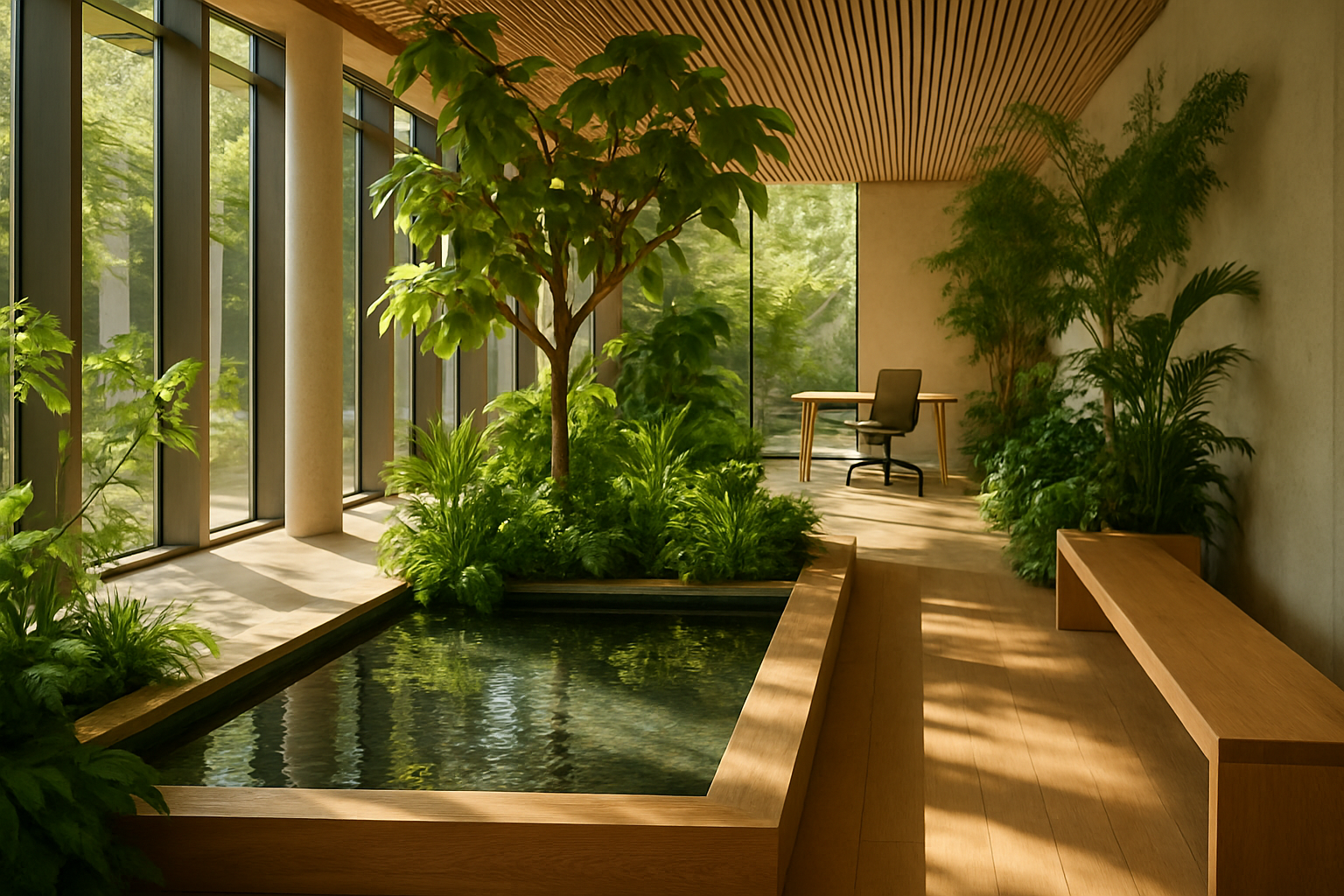Biophilic Design: Cultivating Health Through Nature-Inspired Spaces
Imagine stepping into a room where sunlight dances through leafy patterns, the gentle trickle of water soothes your senses, and natural materials surround you. How does it make you feel? Welcome to the world of biophilic design, where nature and architecture merge to create spaces that not only look beautiful but also enhance our well-being. But what exactly is biophilic design, and how can it revolutionize our approach to health and wellness?

As urbanization has rapidly increased, many people have become disconnected from nature, spending up to 90% of their time indoors. This disconnect has been linked to various health issues, including increased stress, reduced cognitive function, and a higher risk of chronic diseases. Biophilic design aims to bridge this gap by bringing elements of nature into our everyday spaces.
The Science Behind Biophilic Benefits
Recent research has shed light on the profound impact that biophilic design can have on our health and well-being. Studies have shown that exposure to natural elements, even in indoor environments, can lead to significant improvements in both physical and mental health.
One landmark study conducted at a hospital in Pennsylvania found that patients with views of nature from their windows recovered faster and required less pain medication compared to those facing brick walls. This groundbreaking research sparked interest in the potential of biophilic design in healthcare settings.
Further studies have demonstrated that biophilic elements in workplaces can increase productivity, reduce absenteeism, and improve overall job satisfaction. In educational settings, classrooms incorporating natural light and views of greenery have been associated with improved student performance and reduced stress levels.
Key Elements of Biophilic Design
Biophilic design encompasses a wide range of strategies and elements, all aimed at fostering a connection with nature. Some key components include:
-
Direct nature experiences: Incorporating living plants, water features, and natural light into indoor spaces.
-
Indirect nature experiences: Using natural materials, textures, and patterns that mimic nature.
-
Space and place conditions: Creating spaces that reflect natural environments, such as caves or forests.
-
Sensory variability: Introducing changes in light, temperature, and air movement to mimic outdoor conditions.
-
Biomorphic forms and patterns: Integrating shapes and designs inspired by nature into architectural elements.
Implementing Biophilic Design in Various Settings
The versatility of biophilic design allows for its implementation across a wide range of environments, each with unique benefits:
-
Homes: Incorporating natural elements like indoor plants, natural materials, and ample daylight can create a restorative and stress-reducing living space.
-
Offices: Biophilic workplaces have been shown to boost creativity, reduce stress, and improve overall job satisfaction.
-
Healthcare facilities: Hospitals and clinics that integrate nature can enhance patient recovery rates and staff well-being.
-
Educational institutions: Schools and universities with biophilic elements can improve student concentration, reduce stress, and enhance learning outcomes.
-
Retail spaces: Stores that incorporate natural elements can create a more inviting atmosphere, potentially increasing customer dwell time and sales.
Challenges and Considerations
While the benefits of biophilic design are numerous, implementing it effectively can present challenges. Cost considerations, maintenance requirements for living elements, and the need for interdisciplinary collaboration between architects, designers, and health professionals are all factors that must be addressed.
Additionally, it’s crucial to ensure that biophilic design elements are authentic and meaningful, rather than superficial additions. Simply adding a few plants to a space does not constitute true biophilic design; instead, a holistic approach that considers the overall environment and its impact on occupants is necessary.
The Future of Biophilic Design in Health and Wellness
As awareness of the health benefits of biophilic design grows, we can expect to see its principles increasingly integrated into urban planning, architecture, and interior design. The potential for biophilic design to address some of the most pressing health challenges of our time, including stress-related disorders and the rise of chronic diseases, is immense.
Emerging technologies are also playing a role in advancing biophilic design. Virtual reality and augmented reality applications are being developed to bring nature experiences to those unable to access outdoor environments. Additionally, smart building systems are being created to optimize natural light, air quality, and other biophilic elements for maximum health benefits.
Nature’s Healing Touch: Biophilic Design Insights
-
Exposure to nature-inspired environments can lower blood pressure and heart rate within minutes.
-
The use of natural materials like wood in interiors has been shown to improve air quality and reduce stress.
-
Fractals, patterns commonly found in nature, have been linked to reduced physiological stress when incorporated into design.
-
Views of nature from hospital rooms can reduce recovery time by up to 8.5% compared to rooms without nature views.
-
Offices with biophilic design elements report up to 15% higher levels of well-being and 6% higher productivity among employees.
As we continue to uncover the profound impact of our surroundings on our health, biophilic design stands out as a powerful tool for creating spaces that nurture our well-being. By reconnecting with nature in our built environments, we have the opportunity to transform our homes, workplaces, and communities into havens of health and vitality. The growing body of research supporting biophilic design principles offers a compelling case for its widespread adoption, promising a future where our spaces not only shelter us but actively contribute to our physical and mental flourishing.





